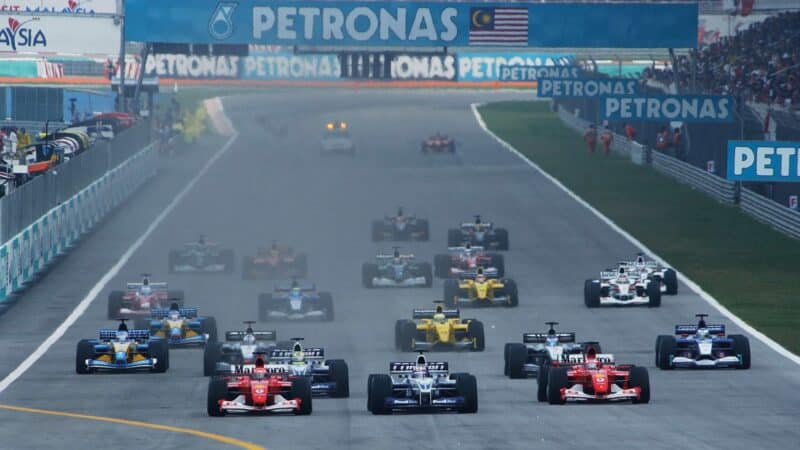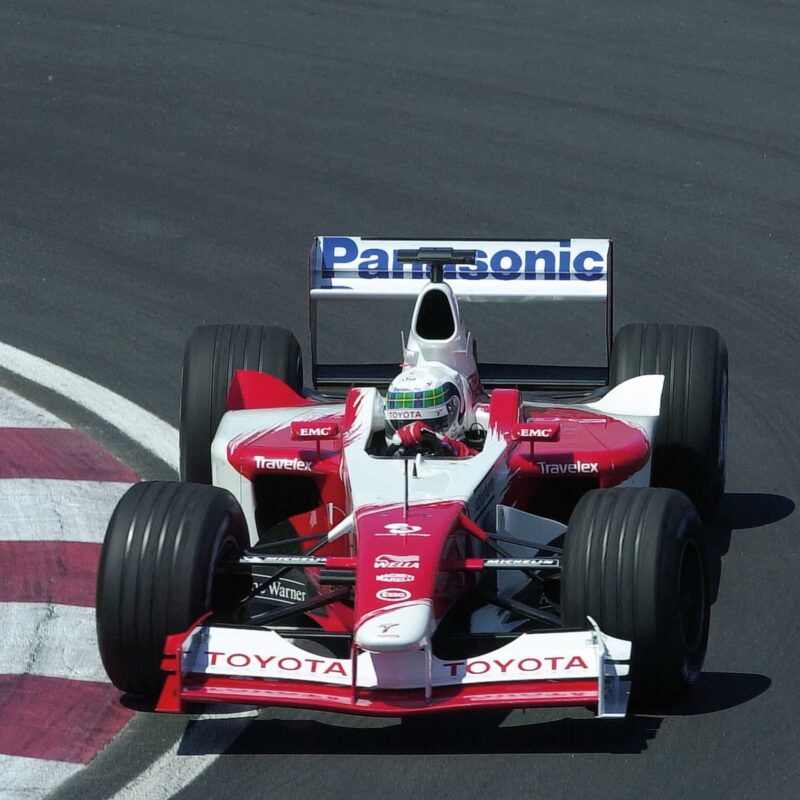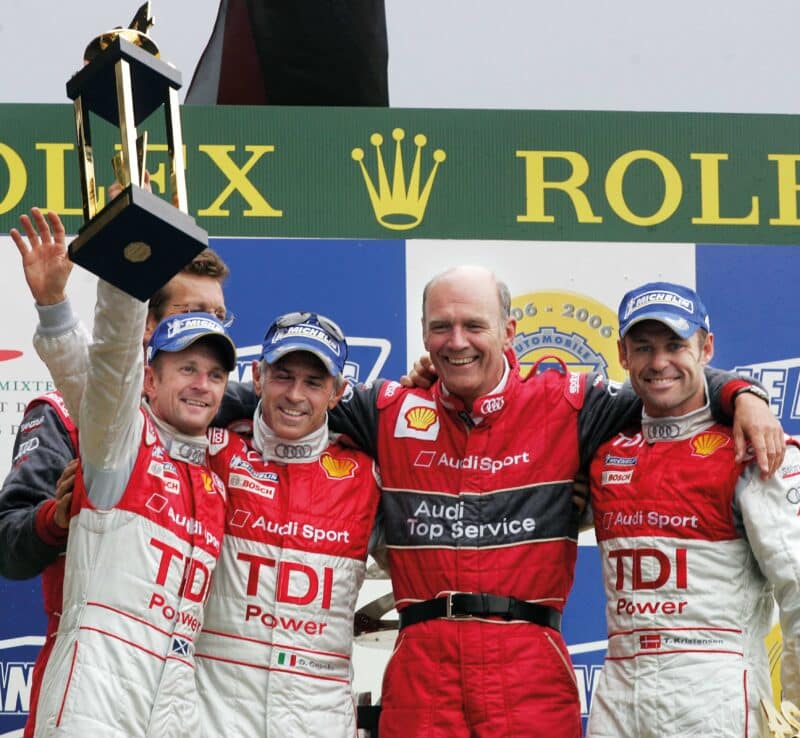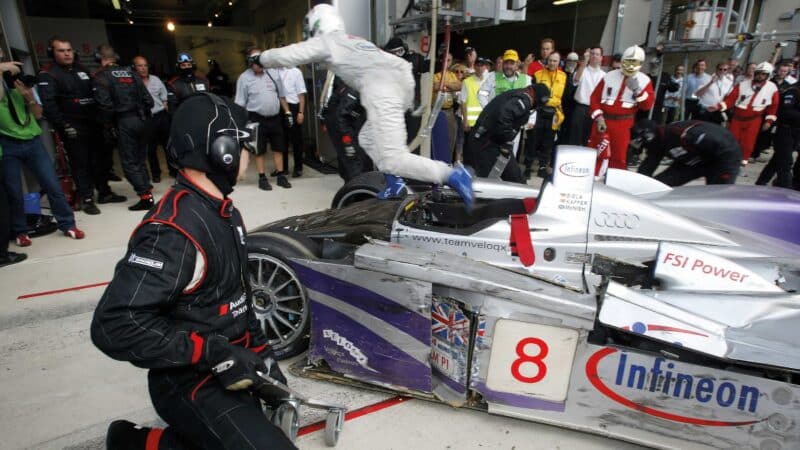
A defence of the past
It is excellent that dear old Murray Walker is starting another spell of F1 commentary. The pre-season ITV programme about his career was well worth staying up for, Murray's account…

Audi AG
My driving career spanned four decades, from junior karting in the 1980s through to my final season with Audi in 2013. The first decade of the millennium was certainly a busy and rewarding time in my life, and included a renewed involvement in Formula 1, testing and then racing with Toyota in 2002 and then as reserve driver at Renault just as that team was growing into a world championship-winning force.

At 32, Allan McNish was given an F1 seat at Toyota, but the season was one of the toughest of his career.
DPPI
That period allowed me to compare how F1 had evolved since the early to mid-1990s when I was a test driver for McLaren and then Benetton. Back then, there was a lot in F1 that was experimental: four-wheel steering, active ride, semi-automatic to full automatic gearboxes. There was a heck of a lot going on in the cockpit, but it was all pretty rudimentary: capable, but basic in comparison to where it got to later on. Now a lot of those systems we worked on were banned, but by the turn of the millennium F1 cars had still moved on to be higher-performing vehicles. Except in one regard: the tyres, which were grooved, a regulation change introduced in 1998 to reduce grip and slow the cars down. Sometimes Bridgestone got it right, sometimes Michelin.
You had other variables between the teams too, but F1 had gone from lots of basic ideas to being very fine-tuned and honed. The other thing was the gap from the front to the back of the grid was much smaller. The team averages were much closer by the early 2000s than they had been 10 years earlier, while heavy-hitter OEMs like Toyota were coming in, spending big. As a championship, technically it had become much more of a pinnacle.

McNish would end 2002 without a single F1 point.
The manufacturer influx meant an expansion in the size of the teams, from a few hundred employees to up to 1000. Now manufacturers were building their own engines and customer teams found themselves in a more difficult position, never mind that budgets were uncapped. You look at it in comparison to now and it appears insane.
We had unlimited testing, so each driver was doing around 60 days, and in 2003 at Renault we would often use two engines per day in testing. That’s something manufacturers could do, but customers couldn’t. The regulations today have evolved with an eye on sustainability for the whole of the grid because it’s not good to have entries that are compromised from the word go.

From left: McNish, Dindo Capello, Audi’s team chief Wolfgang Ullrich and Tom Kristensen, Le Mans winners, 2008
Getty Images
Toyota, with hindsight, is held up as being a prime example of an OEM getting F1 wrong. At the time it wasn’t that straightforward. I’m sure we could all see signs that the writing was on the wall, but we didn’t necessarily act upon it as you would if you were to replay the scenario. The fact of the matter is my team-mate Mika Salo and his engineer Humphrey Corbett were the only two people on the team at the first grand prix in 2002 with any F1 experience. There was a lot of motor sport experience, but not in that niche area, so we were on a bit of a learning curve. It was also clear that the 2002 car wasn’t fit for purpose and they correctly stopped development of it and went straight to 2003. One other factor: the expectations were completely wrong. There was a misalignment of where we were in real terms in comparison to the competition and that set a very unrealistic expectation of where we would finish at the end of the season.
“Toyota is held up as a prime example of an OEM getting F1 wrong”
Being very blunt about it, from my personal point of view the 2002 season was too late in my career to be making my F1 racing debut. In the early 1990s with McLaren and Benetton, with the momentum I had, it could have been a different story. But when the opportunity came up, what was I going to say? It was a straightforward decision. But it was too late, especially in a car that wasn’t quick enough. It was a case of survival, to a great extent. That was brought home to me when Toyota switched Mika and I out, Flavio Briatore called me and I did a deal as reserve at Renault.
My very first lap in the Renault was around Barcelona, and it was quicker than my qualifying lap in the Toyota the previous year. And I was on full tanks, just rubbing off the dust after a winter sitting at home. That was the realisation point of how far we had been from the pace the year before. Even though the grid had closed up the gulf in difference between the ‘wannabees’ and those fighting for wins was significant. Also it was a realisation that I did not want to be back to that scenario where I could say I was a racing driver in F1, but without the power to actually do anything. If I was going to race, it needed to be something competitive, even if it was away from F1.
That leads me to my long association with Audi in sports cars. The first thing I’d say is this was a ‘handshake organisation’. When I did the deal with Dr Ullrich for 2000 it was on a handshake and he stood by it. There was a certain honour there, it wasn’t about the detailed words in the contract. The second thing, you got the feeling it really was a family and he was the godfather. And it had a clear purpose. Audi had budget, no question, but they were an engineering-led company, a car company led from top to bottom by engineers. That gave it a certain difference in mentality because it was not a marketing project. It was to show the technical ability of the company, which is why they started rallying in the 1980s. Sports cars was to show their sports credibility and credentials – it’s in the name – and from that it led directly to the birth of the R8 road car.
As a racing organisation, Audi was like a supertanker. Sometimes it took a long time to change direction, but when they did there was no stopping it – it was going. It was also black or white: you win or you lose. If you lose, what’s the reason? Fundamentally it was a robust engineering organisation which is why Audi won 13 out of its 18 Le Mans.
The first test I did for Audi in 2000 was with Tom Kristensen, who had just moved over from BMW, and we were stuck in the old R8R from the year before. It was at Sebring, on a short circuit I only experienced on that one occasion. We weren’t allowed to play with the new R8 – but actually when we eventually got into it I preferred the 1999 car. It was more compliant and I could maximise its performance straightaway – whereas with the R8, sure, it had a higher level of performance but it was quite pitchy, so over the bumps at Sebring it was fast but not easy to drive. The first experience didn’t lead me to believe it was going to dominate in 2000 and certainly never across the period it did.
I left at the end of the year for Toyota and F1, then went back to Audi in 2004, by which time the R8 had TFSI direct injection. It had a different rear wing structure and set-up – and it was revolutionary. You could do whatever you wanted with it. It was so robust you could rallycross it! It was easy to drive, consistent and the driveability on the throttle was so much better. There had not been many visual changes but under the skin there was a lot that made it so much better.
As for the modular aspect of the R8’s design – how the team could remove and replace the whole rear end within minutes during a race – that was something I never even thought about until I was sitting in the pits at 4am and they were taking the gearbox off! We’d done some practice, but nothing in anger in race conditions.
From memory, the problem was actually a rear hub problem, but the quickest thing to do was change the whole back of the car. Then you had a fresh gearbox, uprights, brake discs, everything. It was much better than changing one part. It was so good they banned the practice.

A quick change at Le Mans in 2004, in which McNish finished at the wrong end of an Audi R8 1-2-3-5
DPPI
In that era, sports car racing was where the big innovations were seen in motor sport because it had an open rulebook, which is one of the reasons Audi liked it. It also was a rulebook that allowed road car relevance. The technology side of it in the middle of that period was moving quicker than I ever expected. When Audi’s engine wizard Ulrich Baretzky said the successor to the R8 was going to be powered by diesel I thought he had been smoking something or drinking too much schnapps. Was it just a PR fad?
We always had a press conference at the Essen show and Frank Biela had just come back from testing the R10 at Vallelunga for the first time. He was the first to drive it and Tom, Dindo Capello and I were sitting there. So what was it like? He just smiled, then said. “You’ll never believe it, guys.” He couldn’t put it into words, because of the torque, the lack of noise. The sensations were so different to what we were used to. I drove that car for the first time at Sebring and there are a few things I remember from that first test. We had to increase the dash size for the display of which gear the car was in because I didn’t have a clue, especially on downshifts – you couldn’t hear the revs. Also when the air was rushing over your helmet at 200kph all you could hear was the wind noise. We were even thinking about piping engine noise into the ear plugs so the driver had some sort of feedback. We eventually went with a honking great display on the dash and obviously got used to it. But it was just such a change from what we knew.
“Biela had come back from testing the R10: ‘You’ll never believe it, guys’”
The hybrids a few years later, we knew that was coming and there had been some hybrid technology in sports car racing before, via Zytek. It was another case where you were building complexity into the car. You still had the engine with all the torque, but then how do you recover and boost energy, and where do you gain and use it? There were lots of different parameters to choose from, including whether you go for a front diff.
The way I describe it is we’d had 100 years of petrol engines, then within 10 years we went from petrol to diesel, diesel to hybrid, 50% hybrid power to full electric in Formula E. It was such an acceleration of technology and options.
Would I swap my time with another? The little boy in me would have loved to have driven in the 1970s but I don’t think I would be here now. My three Le Mans wins span three decades and I think the only other person who has done that is Tom.
We saw an evolution of technology in our era and at the time it was just making the next car faster. But when we look at it now it was changing times in the sport. Go back to the late 1980s/early 1990s you still had a manual gearbox, a radio button on the steering wheel, a drinks button and that was it. You had 200 people working at McLaren and they were the world champions. We had more than 200 people just at Le Mans.
So we saw a development of the sport advancing so quickly in all areas, and actually it was a super-cool time to be involved.